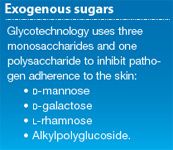Banishing Bacteria: A unique approach for the management of skin diseases (Sponsored by Virbac Animal Health)
The majority of common dermatologic conditions all start with the adherence of pathogens to the skin. A new topical therapy proven to work with the skin's natural defnse mechanisms prevents bacteria from adhering to the skin and thereby reducing infections and inflammation.
It's no secret that veterinarians encounter patients with skin problems on a daily basis.

The majority of common dermatologic conditions—infection with Pseudomonas aeruginosa, Staphylococcus intermedius, and Malassezia pachydermatis as well as inflammation—all start with the adherence of pathogens to the skin.

Spherulite technology
The real revelation is the new topical therapy proven to work with the skin's natural defense mechanisms, preventing bacteria from adhering to the skin and thereby reducing infections and inflammation. Using a combination of tested sugars (carbohydrates), this anti-adhesive technology reduces pathogen adherence to the skin by more than 50% and decreases inflammation by 75% (see Research findings),1-5 a boon to veterinarians facing perplexing skin issues with their patients.

Figure 1. Anti-adhesive action
Glycotechnology
Like all cells, the keratinocytes of the epidermis have glycoproteins that are essential in cell-to-cell communication. However, these glycoproteins also serve as magnets to external pathogens (i.e., Staphylococcus, Pseudomonas) through lectin binding. Microbial lectins are virulence factors located on the surface of the pathogen. Once these pathogens attach their microbial lectins to the skin glycoproteins, they can colonize and cause infection. Attached pathogens can also activate keratinocytes to produce cytokines, such as TNF-α, which cause inflammation.

Table 1. Research findings
Glycotechnology works by applying exogenous sugars (D-mannose, D-galactose, L-rhamnose, Alkylpolyglucoside) that mimic the skin sugars in glycoproteins. These exogenous sugars produce an anti-adhesive effect between the skin sugars and pathogens. Because these exogenous sugars mimic and bind to the skin sugars, they attract and have initial contact with the pathogens' lectins. This initial contact causes the lectin binding sites to become saturated with exogenous sugars—not skin sugars—and, therefore, helps prevent infection and, thus, inflammation.

Exogenous sugars
An added benefit
Traditional methods of managing skin conditions include the administration of antibiotics, antiseptics, and systemic steroids, either oral or injectable. However, the long-term use of these drugs can lead to antibiotic resistance or immunosuppression. Glycotechnology offers practitioners an effective alternative without these drawbacks of traditional therapy.

Key points
For more information about products with Glycotechnology, please visit www.virbacvet.com
References
1. McEwan NA, Reme CA, Gatto H. Sugar inhibition of adherence by Pseudomonas to canine corneocytes. Vet Dermatol 2005;16:204-205.
2. McEwan NA, Reme CA, Gatto H. Monosaccharide inhibition of adherence by Pseudomonas to canine corneocytes, in Proceedings. 2nd Virbac European Symposium, Glycotechnology in Veterinary Dermatology: A New Era, 2005;17-19.
3. Ibisch C, Bourdeau P, Cadiot P, et al. Upregulation of TNF-α production by INF-γ and LPS in cultured canine keratinocytes: application to monosaccharide effects. Vet. Res. Communications 2007;31:835-846.
4. McEwan NA, Reme CA, Gatto H, et al. Sugar inhibition of adherence by Staphylococcus intermedius to canine corneocytes. Vet Dermatol 2006;17:358.
5. McEwan NA, Kelly R, Wooley K, et al. Sugar inhibition of Malassezia pachydermatis to canine corneocytes. Vet Dermatol 2007;3:187-188.
From the expert
Douglas DeBoer, DVM, DACVD, with the University of Wisconsin-Madison's School of Veterinary Medicine, shares his opinions on glycotechnology products.

What can practitioners expect to see with dermatologic cases after implementing glycotechnology-based products?
Every practitioner knows how common—and frustrating—skin infections and inflammation are in everyday practice. Glycotechnology-based topical products incorporate various sugars that inhibit attachment of—and even displace—microbes such as Staphylococcus, Pseudomonas, and Malassezia to—or from—epithelial cells. Therefore, these products may help resolve skin infections and prevent relapses of chronic infections. The sugars also have been shown to decrease inflammatory cytokine release from epithelial cells, suggesting that they may help reduce inflammation.
How can practitioners educate clients about these products?
Clients need to understand your rationale for recommending maintenance therapy, even after resolution of clinical signs. They need to know that certain organisms, such as yeast and staphylococci, are normal inhabitants of skin and that after you eliminate a Staphylococcus or yeast overgrowth problem, nature will eventually return these organisms to the skin.
Measures to limit colonization and growth of these microbes often include long-term antimicrobial shampoo therapy every one to four weeks. As with all shampoo therapies, contact time and frequency are important to stress to owners. All medicated shampoos, including the new glycotechnology-based products, should remain in contact with the skin for 10 to 15 minutes to allow ingredients to act on or penetrate the skin. Be sure to educate your staff members on how to explain correct shampooing techniques to owners.
How do you implement these products in your practice?
I use glycotechnology-based topicals most often with cases of chronic ear infections and atopic dermatitis. Following the resolution of an ear infection, many patients require long-term maintenance therapy, such as gentle irrigation of the ear with a solution. Though most routine ear solutions have a cleansing action, many do not contain ingredients that inhibit microbial growth and, therefore, are less suitable for long-term maintenance therapy than products based on glycotechnology.
With atopic dermatitis, my major goals are inflammation and infection control. Atopic skin is highly colonized by microbes, particularly staphylococci and yeast, and recurrent infections contribute to patient discomfort. Products based on glycotechnology may help reduce microbial attachment and growth and prevent future infections and inflammation—and the need for glucocorticoid, antibiotic, and antifungal treatment.
What are the benefits of using these products?
The biggest potential benefit is fewer relapses in patients with chronic skin and ear disease. Fewer relapses equal less antibiotic use, healthier pets, and happier owners. In addition, it allows the veterinarian to focus more time on other patients.
From a more global view, the chronic use of antibiotics for staphylococcal infections may be a factor in the emergence of antibiotic-resistant strains of staphylococci. Practitioners are becoming increasingly aware of the potential hazards of chronic antibiotic use, and I foresee widespread efforts to limit such use whenever possible. Preventing recurrent skin infections, and thereby minimizing antibiotic use, is not only good for the individual patient but also for animal health in general.